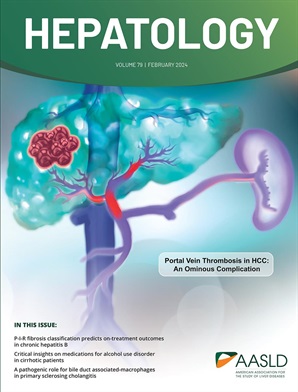器官损伤蛋白质组学特征识别有系统性并发症风险的MASLD患者
IF 12.9
1区 医学
Q1 GASTROENTEROLOGY & HEPATOLOGY
引用次数: 0
摘要
背景:代谢功能障碍相关的脂肪变性肝病(MASLD)影响了世界30%以上的人口,并与多系统合并症相关。我们结合多维组学方法,探索利用高通量靶向循环蛋白质组学追踪系统性器官损伤的可行性,并推断其潜在的分子机制。方法:我们使用深度表型分析评估了患者血清样本中与器官损伤病理生理相关的92个优先蛋白组。我们使用不同的研究设计和跨蛋白质组学平台,纳入了60,042个处于发现和复制阶段的个体的蛋白质组学数据。我们使用反褶积策略来研究受影响的肝脏是否参与器官损伤生物标志物的表达。为了评估选定靶标中细胞类型特异性的转录变化,我们使用了肝类器官数据。研究结果:相关蛋白,包括ADGRG1 (GPR56),在有进展性疾病和显著纤维化风险的患者中失调。在16年的随访中,无论受试者的MASLD状态如何,ADGRG1都与终末期肝病、中度但临床上显著的死亡、慢性阻塞性肺疾病和缺血性心脏病的风险增加相关,因此被验证为器官损伤的替代指标。ADGRG1的肝脏表达反映了循环模式。机制研究表明,在损伤反应中,ADGRG1在纤维化和炎症小生境细胞中的转录谱从低表达转变为上调。结论:我们的研究为与全身性疾病相关的潜在机制提供了一个框架,通过将MASLD患者分为肝外表现风险亚类,促进了整体管理。本文章由计算机程序翻译,如有差异,请以英文原文为准。
Organ damage proteomic signature identifies patients with MASLD at-risk of systemic complications
Background: Metabolic dysfunction-associated steatotic liver disease (MASLD) affects more than 30% of the world’s population and is associated with multisystemic comorbidities. We combined multidimensional OMICs approaches to explore the feasibility of using high-throughput targeted circulating proteomics to track systemic organ damage and infer the underlying molecular mechanisms. Methods: We evaluated a 92-plex panel of prioritized proteins with pathophysiological relevance to organ damage in serum samples of patients using in-depth phenotyping. We included proteomic data from 60,042 individuals in the discovery and replication stages using diverse study designs and cross-proteomic platforms. We used deconvolution strategies to investigate whether the affected liver participated in the expression of biomarkers of organ damage. To assess cell type-specific transcriptional changes in the selected target, we used liver organoid data. Findings: The implicated proteins, including ADGRG1 (GPR56), are deregulated in patients who are at-risk of progressive disease and significant fibrosis. ADGRG1 was validated as a surrogate for organ damage, as it was associated with increased risk of end-stage liver disease, moderate but clinically significant risk of death, chronic obstructive pulmonary disease and ischaemic heart disease over a 16-year follow-up, regardless of the subject’s MASLD status. ADGRG1 liver expression mirrors the circulation pattern. Mechanistic insights show that ADGRG1 shifts its transcriptional profile from low expression to upregulation in cells of the fibrotic and inflammatory niche in response to injury. Conclusions: Our study provides a framework for potential mechanisms associated with systemic diseases that facilitates holistic management by stratifying patients with MASLD into subclasses at-risk of extrahepatic manifestations.
求助全文
通过发布文献求助,成功后即可免费获取论文全文。
去求助
来源期刊

Hepatology
医学-胃肠肝病学
CiteScore
27.50
自引率
3.70%
发文量
609
审稿时长
1 months
期刊介绍:
HEPATOLOGY is recognized as the leading publication in the field of liver disease. It features original, peer-reviewed articles covering various aspects of liver structure, function, and disease. The journal's distinguished Editorial Board carefully selects the best articles each month, focusing on topics including immunology, chronic hepatitis, viral hepatitis, cirrhosis, genetic and metabolic liver diseases, liver cancer, and drug metabolism.
 求助内容:
求助内容: 应助结果提醒方式:
应助结果提醒方式:


